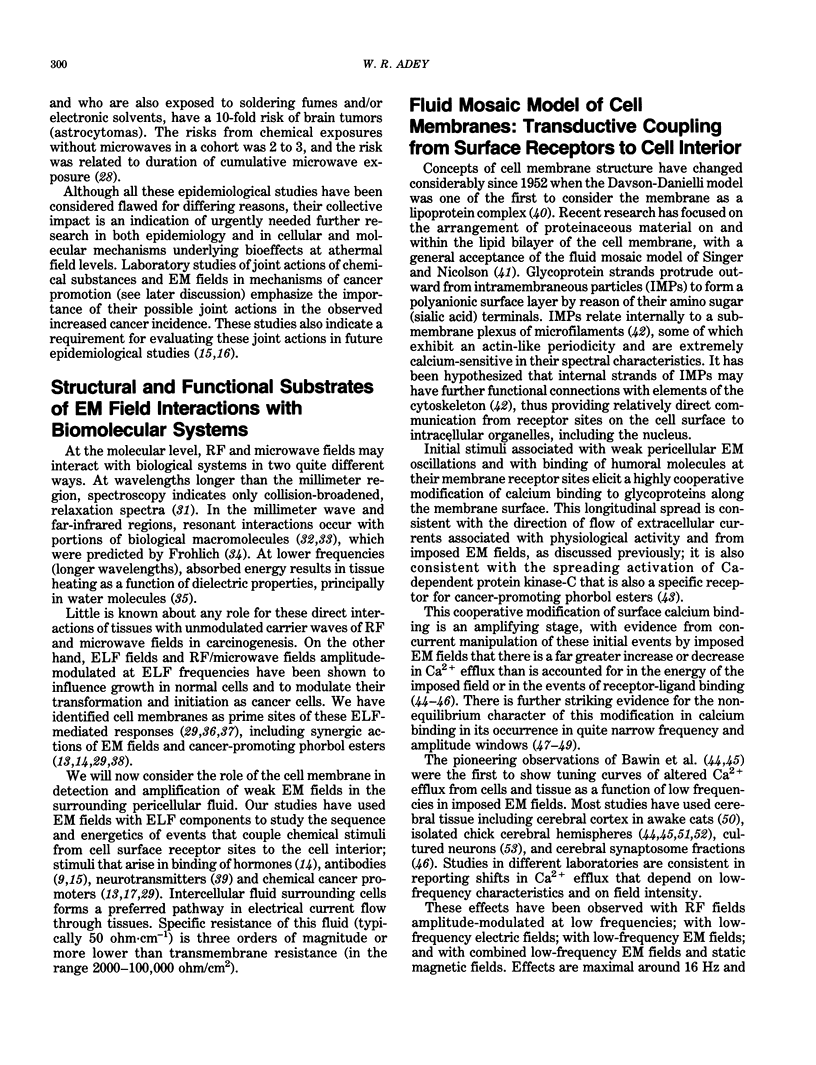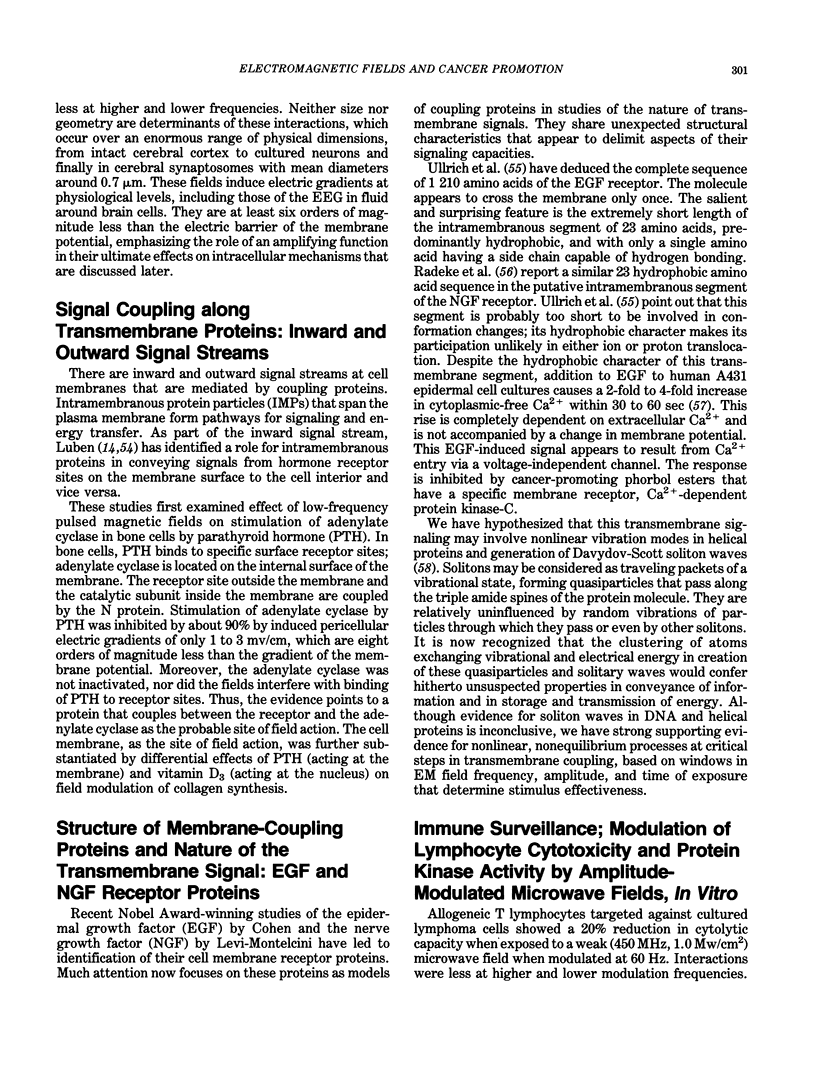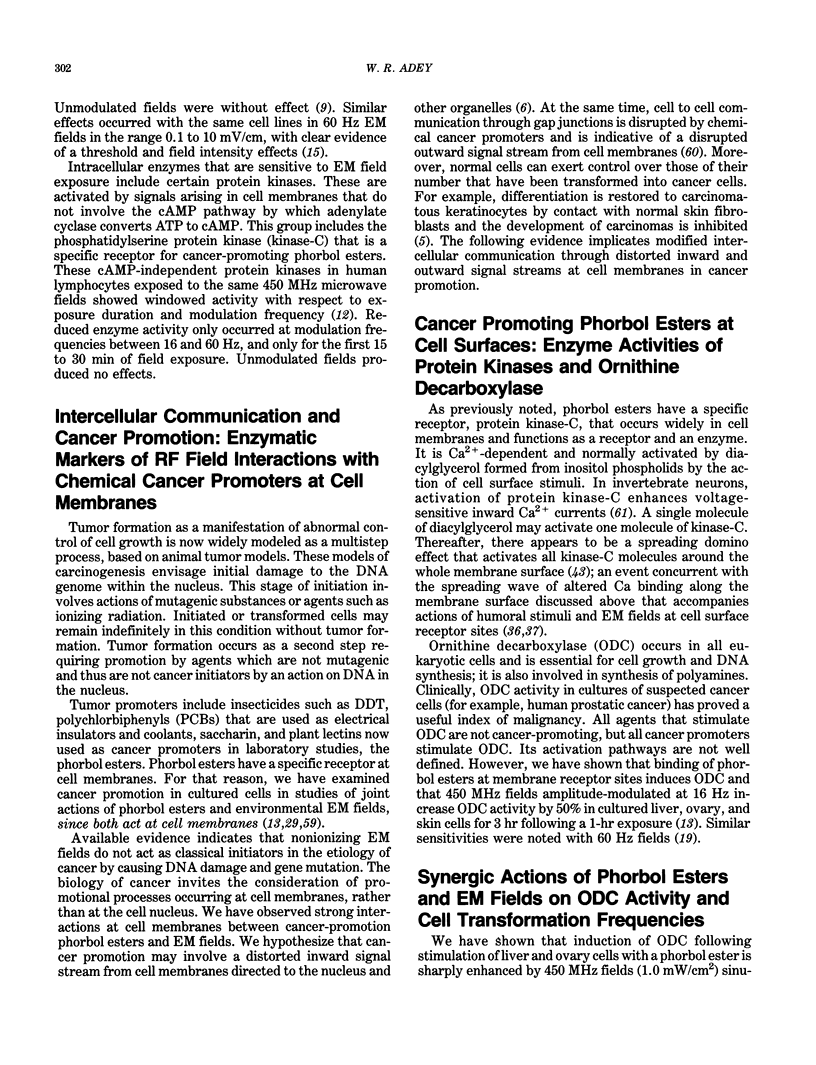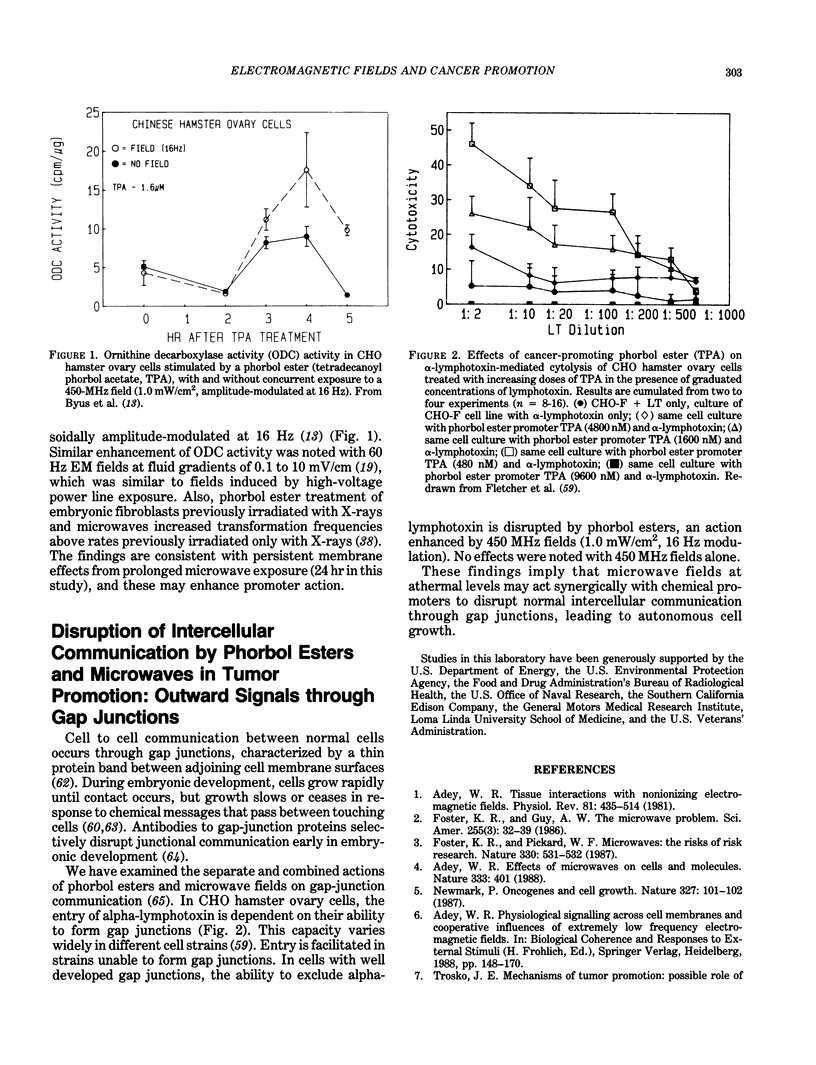Abstract
Studies of environmental electromagnetic (EM) field interactions in tissues have contributed to a new understanding of both normal growth and the biology of cancer in cell growth. From cancer research comes a floodtide of new knowledge about the disruption of communication by cancer-promoting chemicals with an onset of unregulated growth. Bioelectromagnetic research reveals clear evidence of joint actions at cell membranes of chemical cancer promoters and environmental electromagnetic fields. The union of these two disciplines has resulted in the first major new approach to tumor formation in 75 years, directing attention to dysfunctions in inward and outward streams of signals at cell membranes, rather than to damage DNA in cell nuclei, and to synergic actions of chemical pollutants and environmental electromagnetic fields. We are witnesses and, in great measure, participants in one of the great revolutions in the history of biology. In little more than a century, we have moved from organs, to tissues, to cells, and finally to the molecules that are the elegant fabric of living tissues. Today, we stand at a new frontier. It may be more difficult to comprehend, but it is far more significant; for it is at the atomic level, rather than the molecular, that physical, rather than chemical, processes appear to shape the flow of signals that are at the essence of living matter. To pursue these problems in the environment and in the laboratory, our needs for further research with appropriate budgets are great.(ABSTRACT TRUNCATED AT 250 WORDS)
Full text
PDF








Selected References
These references are in PubMed. This may not be the complete list of references from this article.
- Adey R. Effects of microwaves on cells and molecules. Nature. 1988 Jun 2;333(6172):401–401. doi: 10.1038/333401a0. [DOI] [PubMed] [Google Scholar]
- Adey W. R., Bawin S. M., Lawrence A. F. Effects of weak amplitude-modulated microwave fields on calcium efflux from awake cat cerebral cortex. Bioelectromagnetics. 1982;3(3):295–307. doi: 10.1002/bem.2250030302. [DOI] [PubMed] [Google Scholar]
- Adey W. R. Cell membranes: the electromagnetic environment and cancer promotion. Neurochem Res. 1988 Jul;13(7):671–677. doi: 10.1007/BF00973286. [DOI] [PubMed] [Google Scholar]
- Adey W. R. Tissue interactions with nonionizing electromagnetic fields. Physiol Rev. 1981 Apr;61(2):435–514. doi: 10.1152/physrev.1981.61.2.435. [DOI] [PubMed] [Google Scholar]
- Balcer-Kubiczek E. K., Harrison G. H. Evidence for microwave carcinogenesis in vitro. Carcinogenesis. 1985 Jun;6(6):859–864. doi: 10.1093/carcin/6.6.859. [DOI] [PubMed] [Google Scholar]
- Bawin S. M., Adey W. R. Sensitivity of calcium binding in cerebral tissue to weak environmental electric fields oscillating at low frequency. Proc Natl Acad Sci U S A. 1976 Jun;73(6):1999–2003. doi: 10.1073/pnas.73.6.1999. [DOI] [PMC free article] [PubMed] [Google Scholar]
- Bawin S. M., Kaczmarek L. K., Adey W. R. Effects of modulated VHF fields on the central nervous system. Ann N Y Acad Sci. 1975 Feb 28;247:74–81. doi: 10.1111/j.1749-6632.1975.tb35984.x. [DOI] [PubMed] [Google Scholar]
- Blackman C. F., Benane S. G., Kinney L. S., Joines W. T., House D. E. Effects of ELF fields on calcium-ion efflux from brain tissue in vitro. Radiat Res. 1982 Dec;92(3):510–520. [PubMed] [Google Scholar]
- Blackman C. F., Benane S. G., Rabinowitz J. R., House D. E., Joines W. T. A role for the magnetic field in the radiation-induced efflux of calcium ions from brain tissue in vitro. Bioelectromagnetics. 1985;6(4):327–337. doi: 10.1002/bem.2250060402. [DOI] [PubMed] [Google Scholar]
- Byus C. V., Kartun K., Pieper S., Adey W. R. Increased ornithine decarboxylase activity in cultured cells exposed to low energy modulated microwave fields and phorbol ester tumor promoters. Cancer Res. 1988 Aug 1;48(15):4222–4226. [PubMed] [Google Scholar]
- Byus C. V., Pieper S. E., Adey W. R. The effects of low-energy 60-Hz environmental electromagnetic fields upon the growth-related enzyme ornithine decarboxylase. Carcinogenesis. 1987 Oct;8(10):1385–1389. doi: 10.1093/carcin/8.10.1385. [DOI] [PubMed] [Google Scholar]
- DeRiemer S. A., Strong J. A., Albert K. A., Greengard P., Kaczmarek L. K. Enhancement of calcium current in Aplysia neurones by phorbol ester and protein kinase C. Nature. 1985 Jan 24;313(6000):313–316. doi: 10.1038/313313a0. [DOI] [PubMed] [Google Scholar]
- Dixey R., Rein G. 3H-noradrenaline release potentiated in a clonal nerve cell line by low-intensity pulsed magnetic fields. Nature. 1982 Mar 18;296(5854):253–256. doi: 10.1038/296253a0. [DOI] [PubMed] [Google Scholar]
- Dutta S. K., Subramoniam A., Ghosh B., Parshad R. Microwave radiation-induced calcium ion efflux from human neuroblastoma cells in culture. Bioelectromagnetics. 1984;5(1):71–78. doi: 10.1002/bem.2250050108. [DOI] [PubMed] [Google Scholar]
- Fletcher W. H., Byus C. V., Walsh D. A. Receptor-mediated action without receptor occupancy: a function for cell-cell communication in ovarian follicles. Adv Exp Med Biol. 1987;219:299–323. doi: 10.1007/978-1-4684-5395-9_15. [DOI] [PubMed] [Google Scholar]
- Fletcher W. H., Shiu W. W., Ishida T. A., Haviland D. L., Ware C. F. Resistance to the cytolytic action of lymphotoxin and tumor necrosis factor coincides with the presence of gap junctions uniting target cells. J Immunol. 1987 Aug 1;139(3):956–962. [PubMed] [Google Scholar]
- Foster K. R., Guy A. W. The microwave problem. Sci Am. 1986 Sep;255(3):32–39. doi: 10.1038/scientificamerican0986-32. [DOI] [PubMed] [Google Scholar]
- Foster K. R., Pickard W. F. Microwaves: the risks of risk research. Nature. 1987 Dec 10;330(6148):531–532. doi: 10.1038/330531a0. [DOI] [PubMed] [Google Scholar]
- Hydén H. A calcium-dependent mechanism for synapse and nerve cell membrane modulation. Proc Natl Acad Sci U S A. 1974 Aug;71(8):2965–2968. doi: 10.1073/pnas.71.8.2965. [DOI] [PMC free article] [PubMed] [Google Scholar]
- Kikkawa U., Takai Y., Tanaka Y., Miyake R., Nishizuka Y. Protein kinase C as a possible receptor protein of tumor-promoting phorbol esters. J Biol Chem. 1983 Oct 10;258(19):11442–11445. [PubMed] [Google Scholar]
- Lawrence A. F., Adey W. R. Nonlinear wave mechanisms in interactions between excitable tissue and electromagnetic fields. Neurol Res. 1982;4(1-2):115–153. doi: 10.1080/01616412.1982.11739619. [DOI] [PubMed] [Google Scholar]
- Lin-Liu S., Adey W. R. Low frequency amplitude modulated microwave fields change calcium efflux rates from synaptosomes. Bioelectromagnetics. 1982;3(3):309–322. doi: 10.1002/bem.2250030303. [DOI] [PubMed] [Google Scholar]
- Loewenstein W. R. Junctional intercellular communication and the control of growth. Biochim Biophys Acta. 1979 Feb 4;560(1):1–65. doi: 10.1016/0304-419x(79)90002-7. [DOI] [PubMed] [Google Scholar]
- Luben R. A., Cain C. D., Chen M. C., Rosen D. M., Adey W. R. Effects of electromagnetic stimuli on bone and bone cells in vitro: inhibition of responses to parathyroid hormone by low-energy low-frequency fields. Proc Natl Acad Sci U S A. 1982 Jul;79(13):4180–4184. doi: 10.1073/pnas.79.13.4180. [DOI] [PMC free article] [PubMed] [Google Scholar]
- Luben R. A., Cain C. D., Chen M. C., Rosen D. M., Adey W. R. Effects of electromagnetic stimuli on bone and bone cells in vitro: inhibition of responses to parathyroid hormone by low-energy low-frequency fields. Proc Natl Acad Sci U S A. 1982 Jul;79(13):4180–4184. doi: 10.1073/pnas.79.13.4180. [DOI] [PMC free article] [PubMed] [Google Scholar]
- Lyle D. B., Ayotte R. D., Sheppard A. R., Adey W. R. Suppression of T-lymphocyte cytotoxicity following exposure to 60-Hz sinusoidal electric fields. Bioelectromagnetics. 1988;9(3):303–313. doi: 10.1002/bem.2250090311. [DOI] [PubMed] [Google Scholar]
- Lyle D. B., Schechter P., Adey W. R., Lundak R. L. Suppression of T-lymphocyte cytotoxicity following exposure to sinusoidally amplitude-modulated fields. Bioelectromagnetics. 1983;4(3):281–292. doi: 10.1002/bem.2250040308. [DOI] [PubMed] [Google Scholar]
- Milham S., Jr Mortality in workers exposed to electromagnetic fields. Environ Health Perspect. 1985 Oct;62:297–300. doi: 10.1289/ehp.8562297. [DOI] [PMC free article] [PubMed] [Google Scholar]
- Moolenaar W. H., Aerts R. J., Tertoolen L. G., de Laat S. W. The epidermal growth factor-induced calcium signal in A431 cells. J Biol Chem. 1986 Jan 5;261(1):279–284. [PubMed] [Google Scholar]
- Newmark P. Oncogenes and cell growth. Nature. 1987 May 14;327(6118):101–101. doi: 10.1038/327101a0. [DOI] [PubMed] [Google Scholar]
- Rommereim D. N., Kaune W. T., Buschbom R. L., Phillips R. D., Sikov M. R. Reproduction and development in rats chronologically exposed to 60-Hz electric fields. Bioelectromagnetics. 1987;8(3):243–258. doi: 10.1002/bem.2250080304. [DOI] [PMC free article] [PubMed] [Google Scholar]
- Savitz D. A., Wachtel H., Barnes F. A., John E. M., Tvrdik J. G. Case-control study of childhood cancer and exposure to 60-Hz magnetic fields. Am J Epidemiol. 1988 Jul;128(1):21–38. doi: 10.1093/oxfordjournals.aje.a114943. [DOI] [PubMed] [Google Scholar]
- Sikov M. R., Rommereim D. N., Beamer J. L., Buschbom R. L., Kaune W. T., Phillips R. D. Developmental studies of Hanford miniature swine exposed to 60-Hz electric fields. Bioelectromagnetics. 1987;8(3):229–242. doi: 10.1002/bem.2250080303. [DOI] [PubMed] [Google Scholar]
- Singer S. J., Nicolson G. L. The fluid mosaic model of the structure of cell membranes. Science. 1972 Feb 18;175(4023):720–731. doi: 10.1126/science.175.4023.720. [DOI] [PubMed] [Google Scholar]
- Thomas T. L., Stolley P. D., Stemhagen A., Fontham E. T., Bleecker M. L., Stewart P. A., Hoover R. N. Brain tumor mortality risk among men with electrical and electronics jobs: a case-control study. J Natl Cancer Inst. 1987 Aug;79(2):233–238. [PubMed] [Google Scholar]
- Tomenius L. 50-Hz electromagnetic environment and the incidence of childhood tumors in Stockholm County. Bioelectromagnetics. 1986;7(2):191–207. doi: 10.1002/bem.2250070209. [DOI] [PubMed] [Google Scholar]
- Trosko J. E. Mechanisms of tumor promotion: possible role of inhibited intercellular communication. Eur J Cancer Clin Oncol. 1987 Jun;23(6):599–601. doi: 10.1016/0277-5379(87)90252-5. [DOI] [PubMed] [Google Scholar]
- Warner A. E., Guthrie S. C., Gilula N. B. Antibodies to gap-junctional protein selectively disrupt junctional communication in the early amphibian embryo. Nature. 1984 Sep 13;311(5982):127–131. doi: 10.1038/311127a0. [DOI] [PubMed] [Google Scholar]
- Wertheimer N., Leeper E. Electrical wiring configurations and childhood cancer. Am J Epidemiol. 1979 Mar;109(3):273–284. doi: 10.1093/oxfordjournals.aje.a112681. [DOI] [PubMed] [Google Scholar]
- Wertheimer N., Leeper E. Possible effects of electric blankets and heated waterbeds on fetal development. Bioelectromagnetics. 1986;7(1):13–22. doi: 10.1002/bem.2250070103. [DOI] [PubMed] [Google Scholar]
- Yotti L. P., Chang C. C., Trosko J. E. Elimination of metabolic cooperation in Chinese hamster cells by a tumor promoter. Science. 1979 Nov 30;206(4422):1089–1091. doi: 10.1126/science.493994. [DOI] [PubMed] [Google Scholar]


